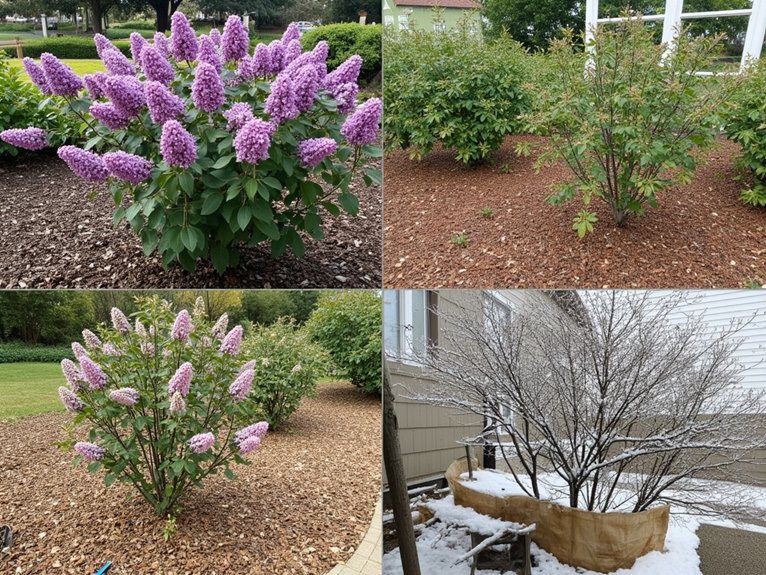Lilacs enchant gardens with their intoxicating fragrance and vibrant blooms, yet many gardeners struggle to maintain consistent flowering throughout the seasons. “The secret lies in understanding each variety’s specific needs,” explains horticulturist Dr. Sarah Chen. While traditional lilacs flower only in spring, proper selection and care techniques can extend blooming periods notably. Modern cultivars, strategic pruning schedules, and precise soil management create the foundation for spectacular year-round displays that transform any landscape.
Contents
- 1 Understanding Different Lilac Varieties and Their Needs
- 2 Essential Sun and Soil Requirements for Healthy Lilacs
- 3 Seasonal Care Guide: From Spring to Winter
- 4 Pruning and Maintenance Techniques for Maximum Blooms
- 5 Common Challenges and Solutions in Lilac Care
- 6 Advanced Tips for Spectacular Flowering Displays
Understanding Different Lilac Varieties and Their Needs

When selecting lilacs for a garden, understanding the distinct characteristics of different varieties helps guarantee successful growth and abundant blooms. The most common varieties showcase unique variety characteristics, from the towering 30-foot Tree Lilac to the compact 3-foot Persian Lilac.
Bloom timing varies greatly between species. Common Lilacs flower in mid-spring with cone-shaped clusters, while Tree Lilacs produce creamy blooms in early summer. Littleleaf varieties offer late-spring flowers, and Persian Lilacs extend the season into early summer. Each type requires specific spacing and care based on its mature size and growth habits.
Essential Sun and Soil Requirements for Healthy Lilacs
Successful lilac cultivation begins with proper sun exposure and soil conditions that support vigorous growth and abundant blooming. The plants require at least 6 hours of direct sunlight exposure daily to produce the best flowers, while shaded areas lead to sparse blooming and leggy growth.
Well-draining soil with a pH between 6.5 and 7.0 creates an ideal foundation for lilac health. Clay-based soils should be amended with peat and sand to improve drainage. “Standing water is a lilac’s worst enemy,” notes horticulturist Dr. Sarah Chen, who recommends testing soil drainage by digging a 12-inch hole and filling it with water.
Seasonal Care Guide: From Spring to Winter

Throughout each changing season, lilac shrubs require specific care and maintenance to guarantee their continued health and abundant blooming cycles. “The secret to spectacular lilac displays lies in adapting your care routine to match nature’s rhythm,” explains botanist Dr. Sarah Chen.
Spring bloomers need fertilization in early March, followed by deadheading after May flowers fade. Summer demands consistent watering and mulching, while fall calls for cleanup and final pruning. Winter protection becomes essential – wrap young plants with burlap and apply a thick mulch layer. Regular inspection for pests and diseases should continue year-round, adjusting treatments based on seasonal challenges.
Pruning and Maintenance Techniques for Maximum Blooms
Proper pruning stands at the heart of abundant lilac blooms, requiring both precise timing and technique for ideal results. Following established maintenance schedules, gardeners should remove spent flowers immediately after blooming and cut away dead or damaged branches to promote healthy growth.
“The key is timing your pruning right after flowering ends,” notes botanist Dr. Sarah Chen. “Cut back approximately one-third of the oldest stems to ground level, focusing on those thicker than two inches in diameter.” This careful approach to pruning techniques guarantees strong blooms for the following season while maintaining the plant’s natural shape and vigor.
Common Challenges and Solutions in Lilac Care

While lilac shrubs are generally hardy plants, several common challenges can hinder their growth and flowering potential throughout the growing season. Effective pest management requires regular monitoring for aphids, scale insects, and borers, which can be controlled using appropriate insecticidal soaps and pruning affected areas.
Frost protection becomes essential during temperature fluctuations, particularly when warm spells are followed by sudden freezes. Covering plants with breathable fabric when frost threatens and maintaining proper soil moisture helps protect vulnerable buds. Other challenges include powdery mildew, which thrives in humid conditions with poor air circulation, and bacterial blight, requiring prompt removal of infected branches.
Advanced Tips for Spectacular Flowering Displays
Creating spectacular lilac flower displays requires mastering several advanced techniques beyond basic care requirements. Successful fertilization strategies include applying a 5-10-10 ratio fertilizer in early spring, followed by monthly applications of balanced nutrients throughout the growing season.
Effective pest management becomes essential for ideal blooming. Dr. Sarah Chen, horticulturist, explains: “Monitor plants weekly for signs of aphids or powdery mildew. Treat immediately with appropriate solutions to prevent bloom damage.” Additional steps include:
- Removing spent blooms within 2 days
- Pruning 1/3 of old wood annually
- Maintaining 2-inch mulch depth around plants
